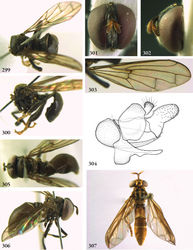Piruwa
| Notice: | This page is derived from the original publication listed below, whose author(s) should always be credited. Further contributors may edit and improve the content of this page and, consequently, need to be credited as well (see page history). Any assessment of factual correctness requires a careful review of the original article as well as of subsequent contributions.
If you are uncertain whether your planned contribution is correct or not, we suggest that you use the associated discussion page instead of editing the page directly. This page should be cited as follows (rationale):
Citation formats to copy and paste
BibTeX: @article{Reemer2013ZooKeys288, RIS/ Endnote: TY - JOUR Wikipedia/ Citizendium: <ref name="Reemer2013ZooKeys288">{{Citation See also the citation download page at the journal. |
Ordo: Diptera
Familia: Syrphidae
Name
Piruwa Reemer gen. n. – Wikispecies link – ZooBank link – Pensoft Profile
Type species:
Piruwa phaecada spec. n. Type locality: Peru, Sachavacayoc.
Description
Body length: 4 mm. Small, slender flies with short antennae and constricted abdomen. Head slightly wider than thorax. Face convex; narrower than an eye. Lateral oral margins not produced. Vertex flat. Occiput narrow over entire length. Eye bare. Eye margins in male not converging at level of frons, with mutual distance 3 times as large as width of antennal fossa. Antennal fossa about as wide as high. Antenna shorter than distance between antennal fossa and anterior oral margin; basoflagellomere longer than scape, oval, about twice as long as wide, bare. Postpronotum bare. Scutellum semicircular; without calcars; with long bristly pile along margin, clearly longer and thicker than pile on rest of scutellum. Anepisternum convex; pilose anterodorsally and along posterodorsal margin. Anepimeron pilose along dorsal margin. Katepimeron convex; bare. Wing: vein R4+5 without posterior appendix; vein M1 straight, perpendicular to vein R4+5; postero-apical corner of cell r4+5 rectangular, with small appendix; crossvein r-m located within basal 1/10 of cell dm. Abdomen constricted, narrowest at transition between tergites 1 and 2, widest at tergite 4; about 2.5 times as long as wide. Tergites 3 and 4 fused, no suture visible. Sternite 1 bare. Male genitalia: phallus furcate near apex, slightly bent dorsad, projecting only a little beyond apex of hypandrium; hypandrium with bulb-like base, with apical part entire, not consisting of two separate lobes; epandrium without ventrolateral ridge; surstylus consisting of two lobes, with basal lobe angular, apical lobe rounded.
Diagnosis
Vein R4+5 without posterior appendix. Antenna shorter than distance between antennal fossa and anterior oral margin. Postpronotum bare. Abdomen constricted.
Discussion
Although there is a superficial similarity in habitus to Paramicrodon (small, slender, short antennae, vein R4+5 without posterior appendix), Piruwa differs from that genus in the following important characters: occiput narrow over entire length; postpronotum bare; scutellum with long bristly pile along margin; anepimeron pilose only along dorsal margin; sternites 3-4 about as wide as sternite 2; hypandrium with apical part not consisting of two separate lobes. Considering these differences, a close relationship between these taxa seems unlikely. Because of these differences and the uncertainy of taxonomic affinities, this distinct taxon is given generic rank.
Diversity and distribution
Described species: 1. Neotropical. Only known from Peru.
Etymology
The name Piruwa is derived from Piruw, the word for Peru in Quechuan, a native Andean-Ecuadorian language. It is to be treated as feminine.
Original Description
- Reemer, M; Ståhls, G; 2013: Generic revision and species classification of the Microdontinae (Diptera, Syrphidae) ZooKeys, 288: 1-213. doi
Images
|
